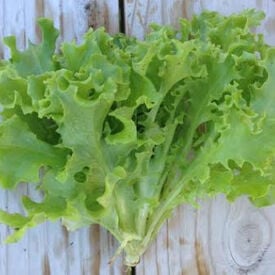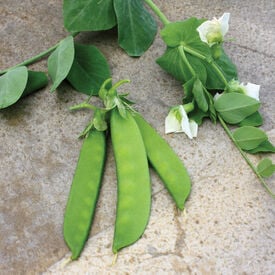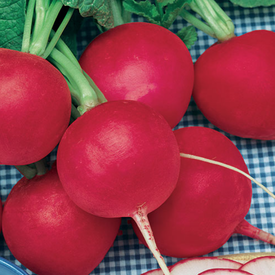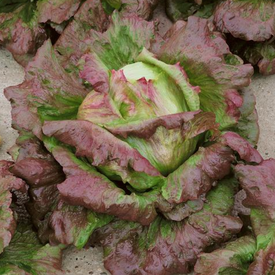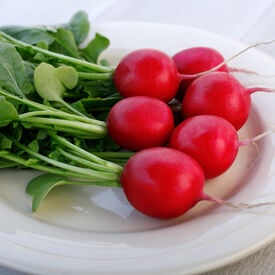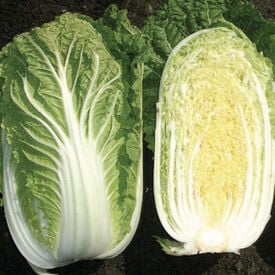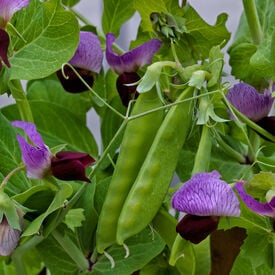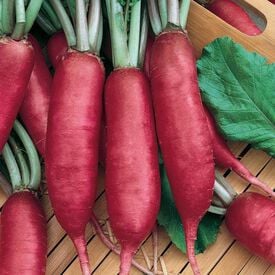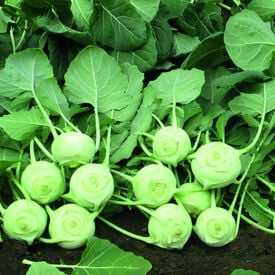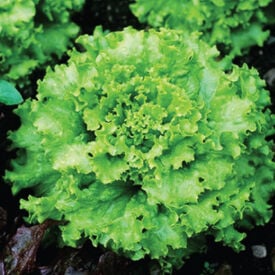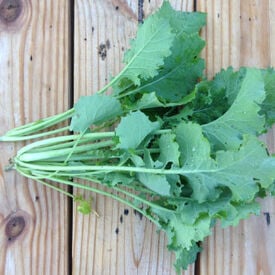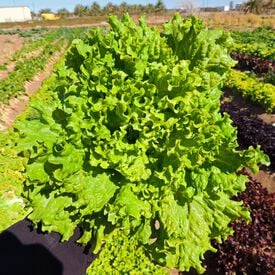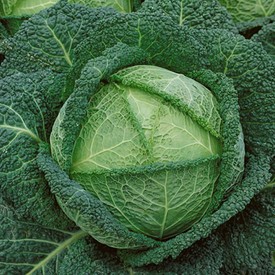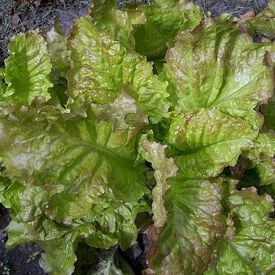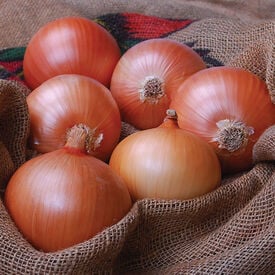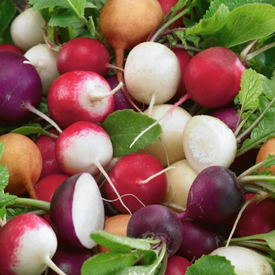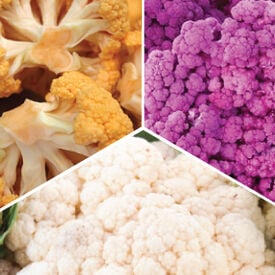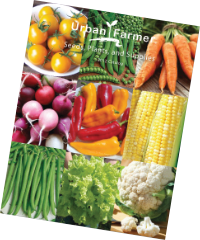Tango Lettuce is a fun curled baby leaf lettuce variety! This lettuce has a crisp clean texture and holds up well with numerous salad dressings. This attractive uniform plant forms tight erect rosettes that are 12" across and 6-8" tall. Tango is an oak leaf variety.
Little SnowPea White produces dwarf-sized vines with beautiful purple flowers. This pea plant is tiny yet productive and does well in small gardens or containers. The pods mature early and have a crunchy bite. Plants will reach a maximum height of 24 inches. For pea shoots, matures in 10 days. Expect slender, tight greens with minimal side branching, upright habit, and ease of harvest and stack.
A 1918 The Great Northern Seed Company says this variety is not withstanding its immense size. This variety does not get hollow or pithy and its flesh remains sparkling white, solid, crisp and juicy. This slower bolting variety has the mildest flavor with a tender, crunchy texture.
The Chrystal Batavian Lettuce is known for its beautifully colored leaves! This lettuce's coloring has a bright purplish red contrast on broad green loose leaves. The Chrystal Batavian is a summer crisp type of lettuce.
Crunchy Crimson radish is a high yielding root with superior quality and uniformity. These roots have bright red skin with excellent interior quality and are very slow to develop pith. Crunchy Crimson grows well under cool conditions.
China Star is a high producing and uniform Chinese cabbage. Grows large heads with a dark green exterior and dark yellow interior. It is slow bolting. China Star performs well in all Chinese cabbage planting slots.
Little SnowPea Purple produces dwarf-sized vines with beautiful purple flowers. This pea plant is tiny yet productive and does well in small gardens or containers. The pods mature early and have a crunchy bite. Plants will reach a maximum height of 24 inches. For pea shoots, matures in 10 days. Expect slender, tight greens with minimal side branching, upright habit, and ease of harvest and stack.
The Pink Summercicle Radish will bring you an endless summer with its bright pink color, sweet taste and popsicle-like shape! These 5-6 inches long roots have a crisp white inside with an extra sweet flavor. This very adaptable variety is best when grown in the early spring or fall. Enjoy the Pink Summercicle in salads or stir-fries!
Thumbelina carrots are tender and sweet with no need to peel! It is the perfect bit size for fresh eating, stews and salads. Thumbelina's small size makes it a great choice for heavy or shallow soils or containers. No wonder it is an All-America Selections Winner from 1992!
The perfect choice for first-time kohlrabi growers as well as those kohlrabi veterans. Konan has a smooth, globe-shaped bulbs that can grow up to 6 inches in diameter and are the perfect upright size and shape for container gardening and garden plots.
Grand Rapid TBR lettuce is a versatile variety derived from the classic Grand Rapid lettuce, known for its resistance to diseases like downy mildew. Originating in the early 20th century, this loose-leaf type features frilled, light green leaves that form a rosette, offering both beauty and texture. The flavor is crisp and mild, making it a delightful addition to salads and sandwiches. Harvesting can begin around 45 days after planting, with the option to pick individual leaves for a continuous supply or to cut the entire head when fully mature. Grand Rapid TBR lettuce thrives in cooler climates and prefers well-drained soil, making it an excellent choice for both spring and fall gardens, particularly for home gardeners seeking a reliable and flavorful crop.
The Dwarf Siberian Kale leaves are perfect as a garnish and in hearty winter dishes. This frilly green and purple kale dances in the crisp early morning cold and thrive. Why? Because its roots are from Russia!
The Waldmans Green Lettuce is the standard green leaf lettuce that is most widely grown for commercial. This variety is a highly productive lettuce that produces large, dark green leaves with slightly savoyed, wavy texture form loose, open heads.
Dark green crumpled leaves, approximate 7 x 9 in. head, 6-8 lb, even better flavor after touched by frost, very tender.
The Prizehead Lettuce produces luscious slow bolting heads of loose, large green leaves with curled maroon tips. This variety is a popular lettuce for both home gardens and markets. Prizehead is truly a prize for its flavor being great in salads and sandwiches.
Avalon is a very sturdy, yet flexible, late intermediate Spanish onion. This variety allows a smooth transition from intermediate to long day varieties. Growers enjoy the easy growth, the size potential, single centers, and the nice firm bulb that it produces. The grower also has the option of mechanical harvesting with Avalon.
The Fiesta Blend is a five color radish blend of red, pink, yellow, white and purple! This colorful blend will be sure to a pop of fun color to any garden. Serving up the Fiesta Blend in salads or dishes is a great addition to any party or gathering!
The Colorful Mix is a fun blend of different colorful cauliflower varieties. Have fun with this colorful mix of cauliflower varieties. This is a great mix to plant and sale at farmers markets. People will marvel at the bright colors! The varieties include Cheddar, Graffiti, and Snowball.
